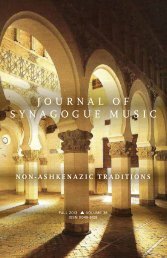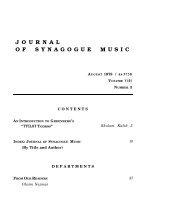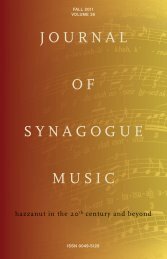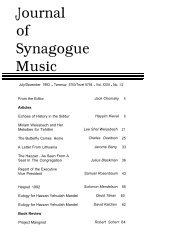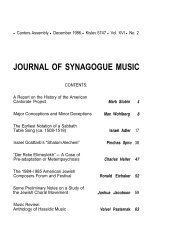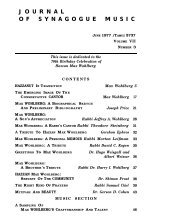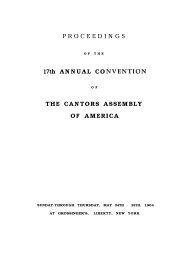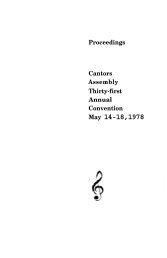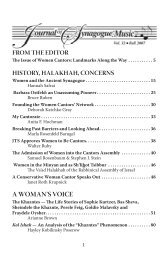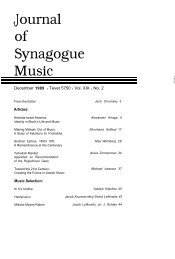ninth annual conference-convention - Cantors Assembly
ninth annual conference-convention - Cantors Assembly
ninth annual conference-convention - Cantors Assembly
You also want an ePaper? Increase the reach of your titles
YUMPU automatically turns print PDFs into web optimized ePapers that Google loves.
SYMPHONY”, and “BAL SHEM SUITE” can be which had played so important a part in his youth.<br />
none other except Jewish themes. In the city of Lodz, which was culturally of great sig-<br />
I am sure that many of you are familiar with the nificance, the center of Jewish musical life was the<br />
“NIGUN” the second part of this suite. * (Vocal illu- Hazomir Singing Society. Like a bee to honey, Zil-<br />
stration). berts was drawn into the aura and activities of the<br />
Jewish music dates back to time immemorial, to the<br />
time of “Ox Yoshir Moshe, King David, King Solomon,<br />
and others of that period. “Shiro V’zimro” was always<br />
part and parcel of Jewish culture. Music occupied<br />
a significant place in the life of the ancient<br />
Jews or Hebrews. It was an integral part of religious,<br />
ritualistic and ceremonial functions, even as<br />
it is today. We are familiar, in our liturgy, with the<br />
“Oleinu”, “Ochilo Loel”, “Vehakohaim” from the<br />
Avoduh, and the Neilah Kaddish, as just a few examples<br />
of music of indisputable Jewish origin.<br />
Yes, JEWISH LIFE WILL PREVAIL FOREVER,<br />
SO WILL ITS MUSIC. From the time of Moses to<br />
today, each generation has added something to the<br />
body of Jewish music. In our time, one of the contributors<br />
has been Zavel Zilberts, whose works are living<br />
proof of the real existence of Jewish music.<br />
Zilbert was born November 7th, 1881 in Karlin, near<br />
Pinsk, Russia. He was one of six sons of his cantor<br />
father Baruch Hersh Zilberts. His musical heritage<br />
expressed itself early, and at the age of eight he was<br />
skilled in solfeggio and assisted in the synagogue<br />
choir. When he was twelve he was placed in charge<br />
of the choir. Two years later, upon the untimely<br />
death of his father, the young Zavel, with the consent<br />
of the congregation, took over the cantorial duties.<br />
He had a thorough knowledge of the Shubbat Nushaot.<br />
His young lyric baritone voice was beginning to mature<br />
and, with his heredity in Hazzanuth, he felt himself<br />
sufficiently capable. A younger brother, Herman,<br />
was entrusted with the responsibilities of the choir,<br />
and Zavel continued to officiate at the pulpit until the<br />
High Holy Days.<br />
Those early years were rich in experience and background.<br />
The repertoire of the synagogue was replete<br />
with the works of the classical composers such as Sulzer,<br />
Naumbourg, Dunajewsky, Gerowitsch and others.<br />
But Zilbert’s experience, successful though he was the<br />
young cantor and choir director, felt the urge to<br />
compose at a comparatively early age and, in fact, his<br />
choir performed two of his compositions at a Tisha<br />
B’av service. Realizing the need for further formal<br />
study, at 18 he applied and was accepted at the Warsaw<br />
Conservatory of Music. Although he showed an unusual<br />
aptitude for composition, he also majored in voice<br />
study and training.<br />
By the time Zilberts graduated from the Conservatory,<br />
his voice had matured and the way seemed open<br />
for a promising career as a vocalist. A trip to Italy<br />
for intensive vocal study was contemplated. But Fate<br />
stepped in, in the person of Cheikel Yanowsky, and<br />
Zilberts’ destiny, was to be that of composer and conductor,<br />
rather than vocalist.<br />
Zilberts had never lost touch with Jewish music,<br />
*Vocal Illustrations by the Author of the Paper.<br />
- 26 -<br />
Hazomir. He was given the opportunity, one day, to<br />
direct the chorus at rehearsal. Cheikel Yanowsky, one<br />
of the great patrons of his time, was impressed by the<br />
competence and self-assurance of young Zilberts and<br />
took him under his wing. Shortly thereafter, the ‘discovered’<br />
Zilberts was placed in charge, to conduct and<br />
direct the Hazomir. Thus began a career of conducting<br />
and composition.<br />
The large chorus and symphony orchestra under his<br />
direction afforded him the rare opportunity, to perform<br />
his own major works, an opportunity of expression<br />
which colored all his future outlooks with a haze and<br />
a tint of the grandiose, the majestic, the epic.<br />
After several years with the Hazomir, in 1907 Zavel<br />
Zilberts was honored with the position as Choir<br />
Master of the Central Synagogue in Moscow. It<br />
was there that his first publication, “Habeit Mishomayim",<br />
appeared in 1908. Incidentally, the title<br />
page was an innoviton in that it bore the photograph<br />
of the Moscow Synagogue, although the music had actually<br />
been composed three years earlier in commemoration<br />
of the “K’doshim” of the Kishinev Pogrom.<br />
His growing reputation was further enhanced as he<br />
conducted the large a capella choir. His field of activities<br />
was broadened as he formed an amateur choral<br />
group which performed many secular works. Besides<br />
folk songs, the group’s programs included original<br />
compositions including some by Yoel Engel, who lived<br />
at that time in Moscow. Engel came to know and<br />
encourage Zilberts. Later, after Zilberts had come to<br />
the United States, they corresponded frequently, until<br />
Engel’s death in Tel-Aviv in 1927.<br />
Seven years after his stay in Moscow, Zavel Zilberts<br />
was persuaded by Cheikel Yanowsky to leave and return<br />
to Lodz. This was 1914. He remained at his<br />
post as conductor of the Hazomir for six years, through<br />
the first World War years and beyond. It seemed<br />
strange to relate that the Germans who overran the<br />
country permitted his program to include, among other<br />
Jewish works, oratorios of the masters in Hebrew<br />
translations by his benefactor, Yanowsky. Incidentally,<br />
his famous “Havdoloh” was written and performed<br />
for the first time in 1916.<br />
It was during this second engagement in Lodz that<br />
Zilberts met and later married his pupil and soloist of<br />
the Hazomir, Amalie. The Zilbertses came to the<br />
United States in 1920, and on August 16th of that<br />
year, Amalie Zilberts was the featured soloist at the<br />
Lewisohn Stadium Concert.<br />
In the United States, Zilberts found his services in<br />
demand, for his reputation had leaped across the vast<br />
ocean. He acquired a bare working knowledge of<br />
English which served him reasonably, although at times<br />
his malaprops were a source of merriment to those<br />
around him.



